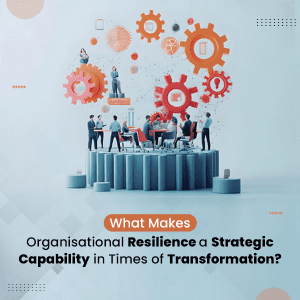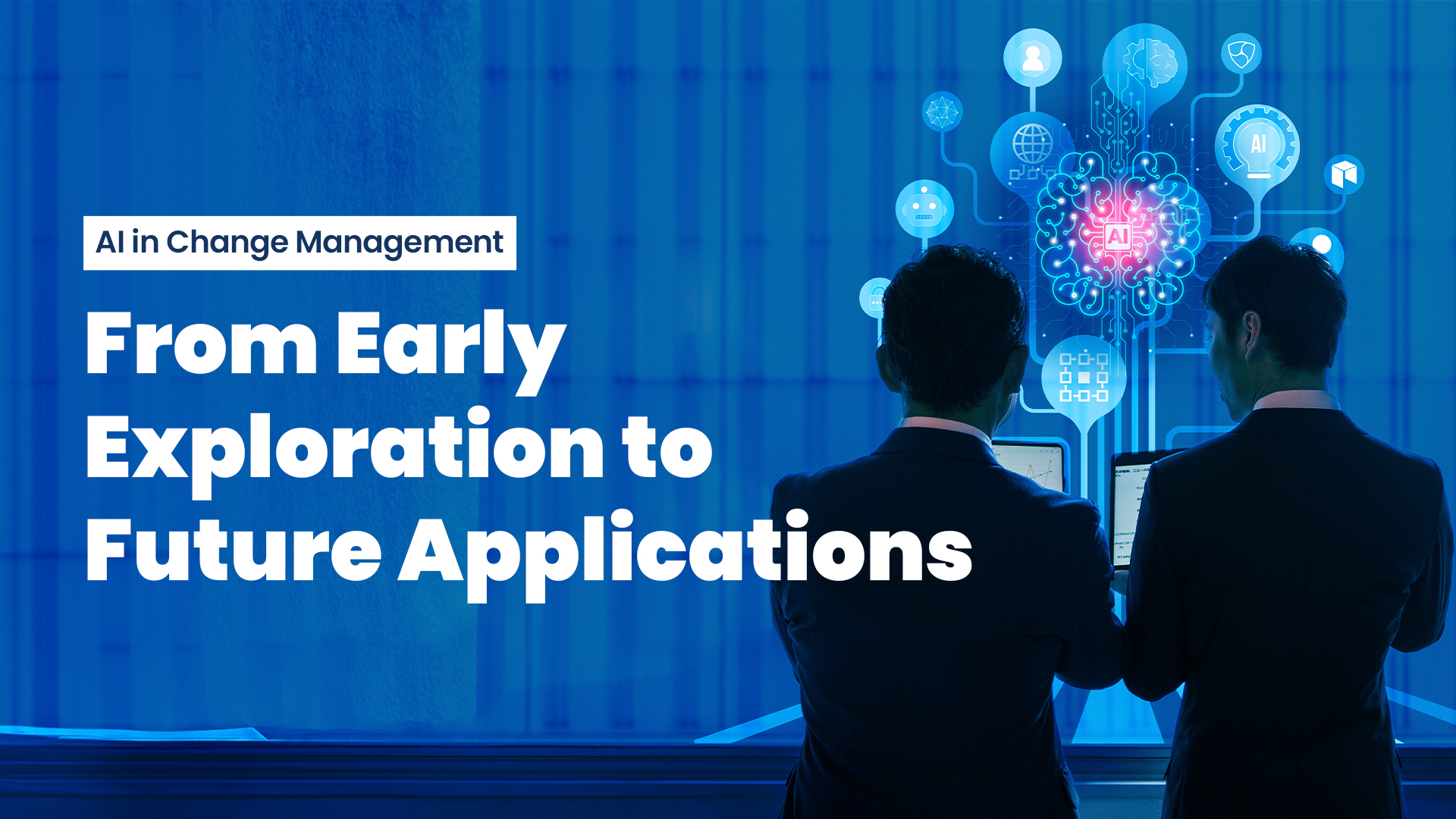
In the early months of 2024, our exploration of Artificial Intelligence (AI) within the realm of organisational change management is only just commencing. At Prosci, we’re immersing ourselves in research to comprehend its implications for our field. We’re delving into questions such as the prevalence of AI tools in change management leadership, their utilization, and the initial advantages they bring.
The discoveries we present represent merely the surface of our investigations. At Prosci, our research mission is characterised by a spirit of humble inquiry, driven by a longstanding thirst for knowledge. We invite you to join us on this journey of discovery, as AI in change management emerges as a lasting presence.
Current State of AI Integration in Change Management
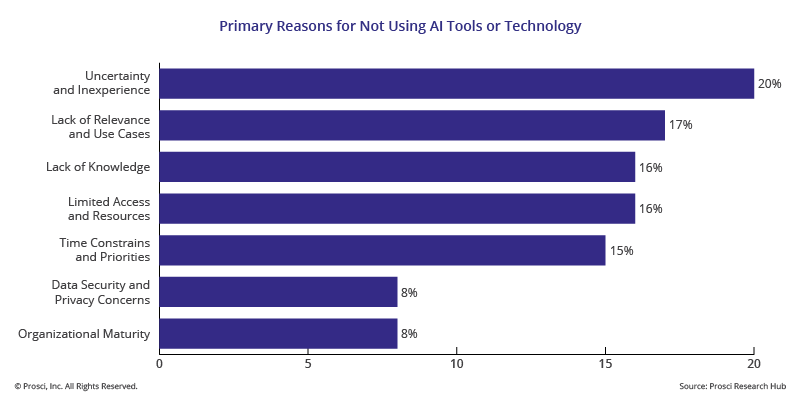
Based on our snapshot of AI study findings in October 2023, it is evident that 84% of surveyed change practitioners possess a moderate to high level of familiarity with AI. However, only 48% acknowledge employing AI tools in their change management endeavours. Among those abstaining from AI usage, several key reasons emerged:
The foremost concerns predominantly revolve around a fundamental lack of comprehension. This includes uncertainties regarding effective AI implementation, limited experience with AI technologies, and apprehensions about unidentified risks. Additionally, a dearth of documented AI use cases specific to change management exacerbates these uncertainties, impacting 53% of respondents collectively.
“I am uncertain about the process, resources, and suitable practices within my organisation.“
Similarly, respondents cited restricted access to AI tools and resources tailored for change management applications, coupled with a lack of familiarity with available resources and their practical deployment. Challenges in securing reliable AI tools, budget constraints, and insufficient organisational support further hindered AI adoption, affecting 16% of respondents.
Furthermore, time constraints and competing priorities in daily tasks hinder 15% of respondents from prioritising AI exploration and learning.
“It’s an additional skill that I lack the time to acquire.“
Concerns regarding data privacy and security remain unresolved for 8% of respondents, encompassing uncertainties surrounding data usage, protection, and the security measures of adopted AI systems.
Lastly, inadequate organisational maturity emerged as a barrier to AI adoption, citing the necessity for a robust depth of change management expertise to effectively integrate AI technology into practice.
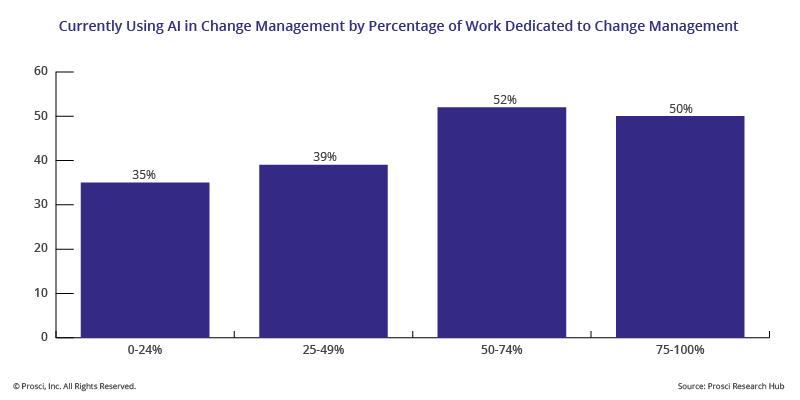
Demographic analysis reveals that seasoned change management professionals with over five years of experience exhibit greater AI usage compared to novices. Additionally, professionals with diversified responsibilities, such as strategy consultants, business leaders, project managers, or executive sponsors, report higher levels of AI integration in their work.
Early Advantages of AI in Change Management
In our initial study, we posed a fundamental question to respondents: What are the effects of AI on your change management practices?
The research revealed several overarching themes, spanning from heightened efficiency to enhanced workload organisation. Participants expressed that the AI tools they utilise have facilitated increased efficiency and productivity through the automation of processes, swift data analysis, idea generation, draft communication and change management plan creation, as well as enhancing response times, among other benefits.
One respondent described employing AI as an “assistant” for workload management, highlighting its tangible advantages:
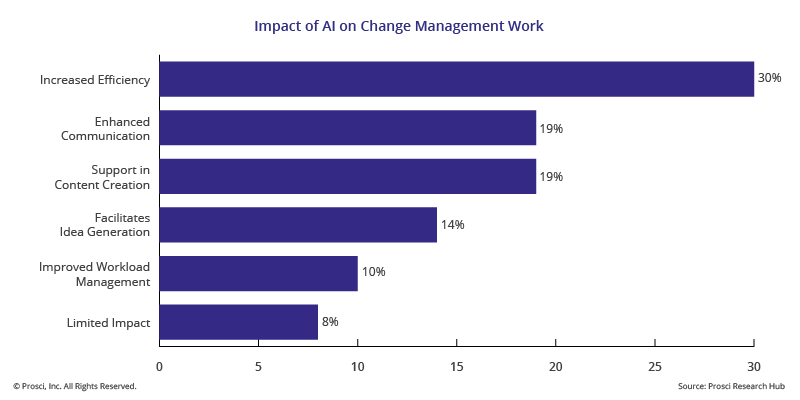
“AI has seamlessly integrated into my current practices, providing a depth of information that would typically require hours to gather and synthesise. It aids in identifying opportunities to rapidly build knowledge and understanding of change management, particularly in scientific and technological domains.“
Utilising AI in Change Management Practices
In addition to investigating the effects of AI, we delved into how change management professionals currently employ AI tools and technologies in their daily tasks. Here are the primary ways they utilise AI today, along with examples extracted from participants’ descriptions:
1. Support in Communications (primarily for existing content)
- Refine existing content
- Address grammatical queries
- Enhance presentations
- Tailor communications for diverse audiences
- Provide initial content drafts
- Assess messaging tone
- Adapt source material for various formats and audience
Example: “Assess the appropriateness of the CEO’s announcement tone for company-wide staff during a rebranding initiative.”
2. Content Generation (primarily for creating new content)
- Develop training materialsz
- Formulate industry-specific case studies
- Produce slide decks
- Rapidly draft communications
- Simplify complex topics
- Craft user personas
- Summarise information
- Generate creative headlines
- Employ unique styles or formats
Example: “Break down the complexities of organisational restructuring into digestible segments for employees, focusing on individual roles and implications.”
3. Strategy and Planning
- Generate tactical ideas for organisational strategies
- Assist in crafting communication and training plans
- Offer suggestions for enhancing communication strategies
- Facilitate simulations and scenario planning
- Develop specific change management strategies (e.g., resistance management)
- Provide feedback on change management plans
Example: “Provide input on the proposed employee engagement strategy concerning the new organisational structure, particularly its effect on team morale.”
4. Automation and Efficiency
- Create personalised training chatbots
- Design bots for FAQs and resource linking
- Utilise chatbots for stakeholder interaction and Q&A sessions
- Develop user personas
- Repurpose text for different platforms
- Analyse and predict individual behaviours
- Produce explanatory videos
- Generate coherent text from keywords
Example: “Develop a chatbot to gather feedback on new HR policies and respond to queries from department managers.”
5. Data Analysis
- Analyse survey data
- Aggregate and verify data
- Assess business cases
- Provide real-time insights based on personal data
- Segment and analyse data for tailored content
- Acquire industry-specific information
- Test hypotheses
- Conduct thematic analysis
Example: “Conduct a thematic analysis of customer feedback on recent product launches to identify key satisfaction factors and areas for enhancement.”
Challenges and Opportunities in AI and Change Management
Despite the tremendous potential AI holds for change management and beyond, many practitioners harbour legitimate concerns. Questions about job displacement, the reliability and security of current AI tools, the risk associated with traditional methods like pen and paper, and potential replacement by younger colleagues loom large.
During a recent webinar, a participant shared a striking remark:
“Failure to grasp AI is akin to being left behind in the digital age.”
Whether professionals are inclined to integrate AI into their workflows or not, a significant portion simply lack awareness of available AI tools. This perhaps explains why 32% of respondents admit to not using AI tools at all.
In reality, many professionals are already leveraging AI in their work without realising it. AI is employed in popular tools for transcription, translation, sentiment analysis, and even predictive text on smartphones. Chatbots in customer support and personalised online advertisements are also AI-driven. Moreover, AI quietly operates in analytical tools integrated with customer relationship management systems and cybersecurity measures.
Yet, society is only scratching the surface of AI’s potential and myriad applications.
Eliezer Yudkowsky, an American AI researcher, aptly warns: “The greatest danger of Artificial Intelligence is premature assumptions of understanding.”
Sixty-five percent of Prosci research participants agree that AI will enhance their future success. However, when considering potential opportunities with AI in change management practices over the next two years, 37% identify deficient AI capabilities within Enterprise Change Management and the Change Management Office (CMO) – a clear area for improvement.
The reality of AI application today is imperfect, but with practice and refinement, the quality of outputs improves. It’s crucial to foster a mindset of ongoing learning and adaptation, as AI continues to evolve and unveil new possibilities.
While 30% of webinar attendees deem organisational adoption of AI as urgent, others are content to defer decisions, perhaps to monitor technological advancements.
Indeed, current heavy users of AI are predominantly early adopters—53% consider themselves as such. However, in practice, only 16% report using AI significantly in their work.
In essence, the journey with AI is still in its infancy, with much yet to be discovered and many innovations on the horizon.
AI and Change Management Research by Prosci
Why does this matter? The data provided here represents a snapshot, capturing a particular moment in time. We are only beginning to comprehend the current landscape and its evolution. New studies by Prosci are underway to further enhance and broaden our understanding. As AI continues to develop and advance, our ongoing investigation into AI and change management
Artificial Intelligence (AI) is an emerging field, not only within change management but across various domains. While early adopters are currently integrating AI into their change management practices, we anticipate a rapid expansion in both the breadth and depth of its application.
will also evolve. This is merely the beginning of a much larger exploration.
The Role of Training and Certification in AI-Enabled Change Management
As organisations experiment with change management AI tools, professional training and credible certification become essential to translate ideas into repeatable practice. Structured programs help practitioners combine technological capability with human-centered methods – ensuring that AI outputs support real adoption and behaviour change.
For professionals and leaders, pursuing Prosci Ai change management learning paths (research-informed programs and certification) provides a practical way to bridge AI capability and the discipline of change. Training gives practitioners a foundation to interpret AI-generated insights, design stakeholder engagement, and measure outcomes in a way that aligns with people-first change principles.
Marg’s Perspective: AI and the Future of Chang Management
While Prosci’s global research highlights the evolving role of AI in transformation, at Marg Business Transformation we see the opportunity to combine AI with proven methodologies like those Advancing Prosci’s frameworks represent.
For us, ai in change management is not a replacement for human-led transformation – it is an enabler. By integrating AI with structured change approaches and equipping leaders through focused learning and certification pathways, organisations can build stronger, future-ready change capability.
AI can enhance stakeholder engagement, enable real-time feedback, and speed up adoption strategies – but it is structured frameworks and human leadership that ensure sustainable impact.
At Marg, we help organisations embed this balance by blending AI-driven insights with practical change leadership, ensuring transformation programs are efficient, empathetic, measurable, and future-proof.
Practical First Steps: How to Start with AI and Change Management
If you’re beginning your AI in change management journey, start small and human-first: identify one repetitive, high-effort task (communications drafts, survey analysis, or FAQ handling) and pilot an AI-supported workflow. Pair the pilot with a change plan – clear sponsorship, stakeholder mapping, simple measurement – and use the learnings to scale. Train a small group on both the AI tool and the change practice so insights translate into behaviour, not just faster outputs.
Conclusion
AI in change management is still in its early stages, but its potential is undeniable. From streamlining communication to enhancing data analysis, AI will reshape how organizations plan, implement, and sustain change. However, technology alone cannot drive transformation. The future belongs to leaders and practitioners who can balance change management AI tools with human-centered leadership, empathy, and resilience.
At Marg Business Transformation, we partner with organizations to make this balance a reality. By combining evidence-based methods, capability building, and AI-enabled tools, we help leaders and teams not just adapt to change – but thrive in it.
Ready to explore how Prosci Ai change management insights and practical AI applications can future-proof your organization? Connect with Marg today to design a tailored transformation journey that blends technology, people, and proven frameworks.

